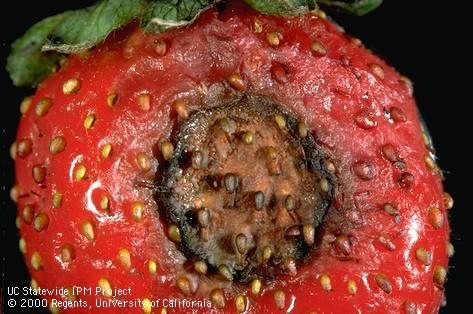Anthracnose is Around Right Now – Caution Advised
We had picture brought in by a grower on Friday of some fruit from his field showing clear signs of anthracnose. That is to say, dark, lens shaped lesions on the fruit. It's understood that these are very early fruit and they have been exposed to some pretty tough conditions but nevertheless knowing that this disease is around gives reason for concern for local PCA's and growers.
While temperatures in the upcoming week are leaning on the cool side of the 20-25o C (68-77o F) optimum for the disease, the abundance of precipitation predicted and the resulting splashing onto flowers, fruit and leaves is going to be good for disease growth and spread.
Briefly, anthracnose in strawberry is most often caused by the pathogen Colletotrichum acutatum, and can have a number of sources, including the soil, the surrounding environment or the plants themselves. What we saw are the lesions on the fruit, and these lesions start as small sunken oval to round brown to black spots (some people describe them as “cigarette burns”) that can expand to the entire fruit.
What to do about an anthracnose fruit infestation in strawberry is fairly straightforward. For conventional growers there are several fungicides (see the UC IPM link below for specifics) registered for topical application, and if one is unable or not willing to spray, physical removal of the infested fruit will help to reduce the disease load.
A lot has been written about anthracnose in strawberry already:
https://ipm.ucanr.edu/agriculture/strawberry/anthracnose/
And we at the UC have put out a wonderful grower guideline about it as well:
https://ucanr.edu/blogs/strawberries_caneberries/blogfiles/47929.pdf
And that same guide is also available in Spanish:
https://ucanr.edu/blogs/strawberries_caneberries/blogfiles/47930.pdf
Also, the grower who came spoke Spanish and was wondering if we don't have the UC IPM guidelines in Spanish? Why, of course we do, the link is posted here:
https://ipm.ucanr.edu/legacy_assets/pdf/pmg/pmgstrawberry_espanol.pdf
Even more, Gerald Holmes from the CalPoly Strawberry Center wrote in to remind us of the excellent efficacy and timing guide that can be referenced for anthracnose in strawberry:
https://ipm.ucanr.edu/legacy_assets/pdf/pmg/fungicideefficacytiming.pdf

Classic symptom of anthracnose on strawberry fruit, brown to black sunken spot. Photo courtesy UC IPM.


Posted by Gerald Holmes on February 28, 2024 at 3:34 PM